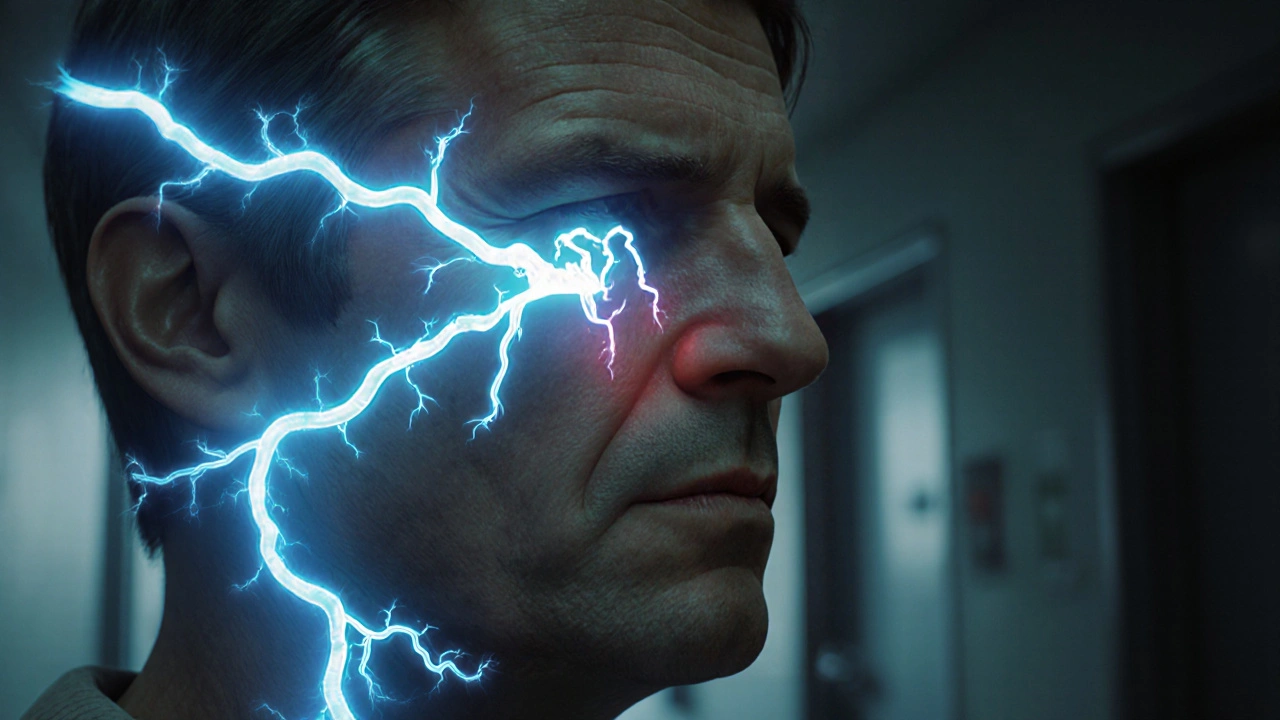
Baclofen Dosing Calculator for Trigeminal Neuralgia
Key Takeaways
- Baclofen is a muscle‑relaxant that works on GABA‑B receptors and may reduce facial pain for some trigeminal neuralgia patients.
- Evidence is mixed; baclofen is usually considered when first‑line drugs like carbamazepine cause unwanted side effects.
- Typical starting dose is 5mg three times a day, gradually increased to 60mg daily, but exact dosing must be personalized.
- Common side effects include drowsiness, dizziness, and weakness; serious risks are rare but include low blood pressure and withdrawal if stopped abruptly.
- Always discuss with a neurologist before adding baclofen, especially if you are on other anticonvulsants or have kidney issues.
Understanding Trigeminal Neuralgia
Trigeminal Neuralgia is a chronic facial pain disorder caused by irritation or compression of the trigeminal nerve, the fifth cranial nerve that carries sensation from the face to the brain. Episodes feel like electric shocks, often triggered by simple actions such as chewing, brushing teeth, or even a light breeze. The condition affects roughly 0.03% of the population, with a higher incidence after age50. Because the pain is sudden, severe, and unpredictable, patients frequently report anxiety, sleep disruption, and reduced quality of life.
How Baclofen Works
Baclofen is a prescription medication classified as a muscle relaxant that acts as a selective agonist at GABA‑B receptors. By stimulating these receptors in the spinal cord and brainstem, baclofen dampens the release of excitatory neurotransmitters, which in turn can lower the firing rate of hyper‑active nerve fibers. Although it was originally developed to treat spasticity in conditions like multiple sclerosis, clinicians have explored its analgesic potential for neuropathic pain syndromes, including trigeminal neuralgia.
The drug also influences the pain pathway by modulating descending inhibitory signals that travel from the brain to the dorsal horn of the spinal cord. This dual action-reducing muscle tension and enhancing central inhibition-forms the scientific basis for using baclofen as an adjunct therapy in trigeminal neuralgia.

What the Research Says
Randomized controlled trials specifically targeting baclofen for trigeminal neuralgia are scarce. One small open‑label study from 2019 enrolled 24 patients who could not tolerate carbamazepine; 58% reported at least a 30% reduction in attack frequency after 8weeks of baclofen titration. A 2022 systematic review that pooled data from case series and observational cohorts concluded that baclofen may provide modest relief, but the quality of evidence remains low due to small sample sizes and lack of blinding.
In practice, baclofen is most often prescribed when first‑line agents (carbamazepine, oxcarbazepine) cause adverse effects such as hyponatremia or diplopia, or when patients have contraindications to anticonvulsants. Some neurologists also pair baclofen with low‑dose carbamazepine to achieve synergistic pain control while minimizing each drug’s dose‑related side effects.
Typical Dosage for Trigeminal Neuralgia
Because baclofen’s analgesic effect appears dose‑dependent, clinicians start low and go slow:
- Day1-3: 5mg three times daily (15mg total).
- Day4-7: Increase to 5mg four times daily if well tolerated.
- Week2-4: Gradually raise by 5mg per dose every 3-4days until reaching a target of 20-30mg three times daily (60‑90mg total), or until side effects limit further increase.
Maximum recommended daily dose is 80mg; however, some specialists report successful pain control at 100mg in refractory cases, but only under close monitoring. Dose adjustments are essential for patients with renal impairment because baclofen is cleared primarily via the kidneys.
Side Effects and Safety Considerations
Common adverse reactions (incidence>10%) include:
- Drowsiness or fatigue.
- Dizziness, especially when standing quickly.
- Weakness or reduced coordination.
- Nausea and mild gastrointestinal upset.
Less frequent but clinically significant risks are:
- Hypotension or bradycardia.
- Respiratory depression at high doses, particularly when combined with other central depressants (opioids, benzodiazepines).
- Withdrawal syndrome if the drug is stopped abruptly after prolonged use, manifesting as rebound spasticity, seizures, or severe anxiety.
Important contraindications include severe renal failure (creatinine clearance<30ml/min) and known hypersensitivity to baclofen. Pregnant or breastfeeding women should only use baclofen if the potential benefit outweighs the risk, as data on fetal safety are limited.
Comparing Baclofen with Other Common TN Therapies
| Medication | Typical Dose | Primary Action | Pros | Cons |
|---|---|---|---|---|
| Carbamazepine | 200‑1200mg/day divided | Voltage‑gated Na⁺ channel blocker | High efficacy (60‑80% responders); fast onset | Hyponatremia, dizziness, rash; drug interactions |
| Gabapentin | 900‑3600mg/day divided | Calcium channel α₂δ subunit modulator | Better tolerated; useful in combination | Weight gain, edema, sedation; requires titration |
| Baclofen | 5‑80mg/day divided | GABA‑B receptor agonist (central muscle relaxant) | Helps when other drugs cause side effects; oral easy | Limited analgesic data; drowsiness, withdrawal risk |
| Microvascular Decompression (MVD) | - (surgical) | Physical relief of nerve compression | Potential cure; long‑term relief | Invasive, risks of infection, facial numbness |
The table highlights that baclofen is not a first‑line choice but can fill a niche for patients who cannot tolerate or do not fully respond to carbamazepine or gabapentin. When surgery is an option, it usually offers the most durable outcome, but many patients prefer a medication‑first approach.
Practical Tips for Patients Considering Baclofen
- Start the medication exactly as prescribed; do not self‑adjust the dose.
- Take each dose with food to minimize stomach upset.
- Track attack frequency and intensity in a simple diary; note any new side effects.
- Avoid driving or operating heavy machinery until you know how baclofen affects you.
- If you miss a dose, take it as soon as you remember unless it’s close to the next scheduled dose-then skip the missed one.
- Never stop baclofen abruptly; taper down over at least 1week under medical supervision.
- Inform your dentist and any surgeon about baclofen use, especially if you are undergoing procedures that involve anesthesia.
Open communication with your neurologist is key. Share the pain diary, discuss any bothersome side effects, and ask whether a combination therapy (e.g., low‑dose carbamazepine plus baclofen) might achieve better control with fewer adverse reactions.
Frequently Asked Questions
Can baclofen cure trigeminal neuralgia?
No. Baclofen may lessen the frequency or intensity of pain attacks, but it does not address the underlying nerve compression that often causes trigeminal neuralgia. For a potential cure, surgical options such as microvascular decompression are considered.
How long does it take to feel pain relief after starting baclofen?
Most patients notice a modest reduction within 1‑2weeks of reaching an effective dose, though some need up to 4weeks. The response is highly individual and depends on dose, concurrent medications, and the severity of the nerve irritation.
Is it safe to combine baclofen with carbamazepine?
Yes, many clinicians prescribe both to achieve better pain control while keeping each drug’s dose lower. However, close monitoring for dizziness, excessive sedation, or blood‑pressure changes is essential.
What should I do if I miss a dose?
If you remember within a few hours, take the missed dose. If it’s almost time for your next scheduled dose, skip the missed one and continue the regular schedule. Do not double‑dose.
Can baclofen cause dependence?
Physical dependence can develop after several weeks of high‑dose use. That’s why a gradual taper is required when stopping the medication to avoid withdrawal symptoms such as rebound spasticity or anxiety.




14 Comments
Start low, go slow-5 mg three times daily is the typical initiation, and you should only increase if you tolerate it without dizziness or excessive drowsiness. The GABA‑B agonism of baclofen dampens excitatory transmission, which can blunt the paroxysmal firing that characterizes trigeminal neuralgia attacks. Because the drug is cleared renally, patients with impaired kidney function need a reduced regimen and close lab monitoring. If you’re already on carbamazepine, watch for additive sedation; sometimes a modest baclofen dose lets you lower the anticonvulsant dose and still keep pain under control.
Sounds like you’ve got a solid plan-just remember to keep a symptom diary so you can see whether the dose tweaks are actually making a difference. Also, don’t forget to discuss any new weakness or balance issues with your neurologist; early tweaks can prevent bigger problems later.
Keep the titration slow and watch for dizziness.
One must marvel at the audacity of modern pharmacology, offering a mere muscle relaxant as a beacon of hope for the tormented facial nerve. Yet, beneath the glossy abstracts lies a tapestry of modest relief, barely enough to eclipse the relentless electric shocks that define this malady. The literature, though sparse, whispers of a 58 % responder rate-still a whisper in a cacophony of suffering.
In the annals of neuropathic therapeutics, baclofen occupies a niche both intriguing and precarious, a dichotomy that demands meticulous scholarly attention.
Its mechanism, as an agonist at the GABA‑B receptor, engenders a cascade of inhibitory neurotransmission that, in theory, tempers the hyper‑excitability of the trigeminal afferents responsible for lancinating pain.
Empirical investigations, albeit limited in scale, have illuminated a modest yet statistically discernible attenuation of attack frequency, particularly when employed as an adjunct to carbamazepine.
The titration protocol, commencing at five milligrams thrice daily, epitomizes the principle of “start low, go slow,” a maxim that safeguards against the insidious onset of somnolence, vertigo, and generalized weakness.
Renal clearance dictates a prudent dose reduction in patients exhibiting compromised glomerular filtration, lest accumulation precipitate severe hypotension or respiratory depression.
Moreover, the specter of withdrawal looms ominously should baclofen be abruptly discontinued after prolonged use, manifesting as rebound spasticity, heightened anxiety, and, in extreme cases, seizure activity.
Clinical praxis thus mandates a gradual taper, mirroring the incremental escalation employed during initiation.
The confluence of baclofen with low‑dose antiepileptics frequently yields a synergistic effect, permitting each agent to be utilized at sub‑maximal dosages while preserving analgesic efficacy.
Observational cohorts have reported that a daily intake approaching eighty milligrams may be tolerated in select refractory cases, though such regimens necessitate vigilant hemodynamic monitoring.
It is incumbent upon the prescribing neurologist to assess concomitant central depressants, given the additive risk of respiratory compromise.
Patient education, therefore, must encompass not only the mechanistic rationale but also the practical admonitions regarding orthostatic hypotension and the perils of alcohol ingestion.
In the crucible of real‑world application, the therapeutic index of baclofen remains narrow, and its utility is best reserved for those who have exhausted first‑line anticonvulsants due to adverse effects or contraindications.
Ultimately, while baclofen does not constitute a panacea, it represents a valuable component within a multimodal armamentarium aimed at restoring quality of life to those besieged by facial neuralgia.
That overview really clarifies the risk‑benefit balance-especially the point about tapering to avoid withdrawal. It’s also helpful to know the renal considerations; I’ll be sure to flag that with my doctor if my labs ever dip.
Great summary-just add that staying in close contact with your neurologist during dose adjustments can catch side‑effects early, making the whole process smoother.
While the data drizzle in, the occasional cherry‑picked study makes baclofen look like a miracle, but the small sample sizes and lack of blinding keep it from being a reliable weapon against trigeminal onslaughts.
yeah i get that most of the time the studies are tiny and not super solid so we should be careful before we hype it up
Our own doctors should push for more home‑grown research instead of borrowing half‑baked foreign studies that ignore the unique genetics of our population.
Absolutely, building a localized evidence base is crucial 🙌 – many patients here have different metabolic profiles, and without region‑specific trials we risk mis‑dosing or overlooking side‑effects that could be more prevalent in our community 😊. Investing in local studies will also empower physicians to tailor baclofen regimens that respect cultural nuances and dietary habits, ultimately improving adherence and outcomes.
Even with limited data, the fact that baclofen can offer any relief is a beacon of hope for those trapped in relentless pain cycles.
Some say the pharma giants downplay baclofen’s potential because it threatens their monopoly on pricey anticonvulsants; the shadows of corporate greed often eclipse genuine breakthroughs, leaving patients to patch together fragmented evidence while hoping for a miracle.
Indeed, the intertwining of profit motives with medical research, while disheartening, highlights the necessity for independent studies, rigorous peer review, and transparent data sharing, all of which can illuminate the true efficacy of baclofen and safeguard patient interests.